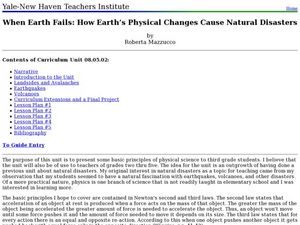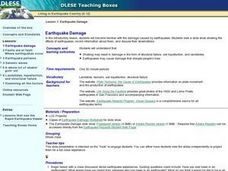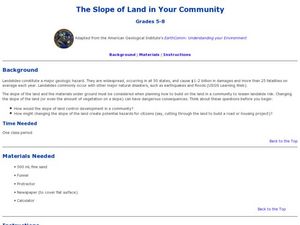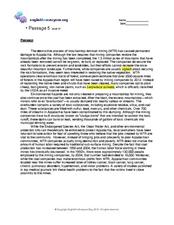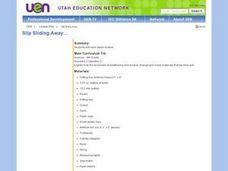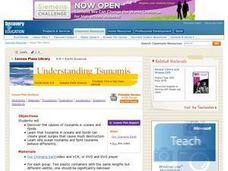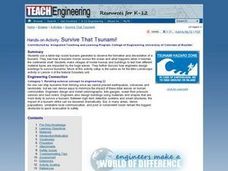Curated OER
Mini-Landslide
Students explore how different materials (sand, gravel, lava rock) with different water contents on different slopes result in landslides of different severity. They measure the severity by how far the landslide debris extends into model...
Curated OER
Watch Out for Landslides
Students conduct an experiment. In this landslides lesson, students learn about landslides and discuss how they could minimize the risk of landslides. Students complete an experiment to see if changing the slope of the land...
Curated OER
Avalanche And Landslide Hazards in Canada
High schoolers explore where the natural disasters, avalanche and landslides, are most frequent in Canada and investigate their associated causes and effects. They navigate the Atlas of Canada Web site for natural hazards.
Curated OER
Hazards: Third Grade Lesson Plans and Activities
Learners discover hazards related to volcanoes and predict the effects these hazards have on people and land. As blossoming geologists explore various volcanic eruptions, including the hazards associated with them, they...
Curated OER
Landslides
Students study a natural disaster. In this landslides facts lesson, students discover how and why landslides happen and how they have an effect on people. They discuss this information as a class and then work in small groups to create...
Curated OER
When Earth Fails: How Earth?s Physical Changes Cause Natural Disasters
Young scholars examine natural disasters and some safety measures that should be followed. In this natural disaster activity students write a narrative, and research safety procedures.
Curated OER
TE Lesson: Land on the Run
Students study the causes of different types and speeds of landslides. They determine that landslides are the result of gravity, friction, and the materials involved. They examine the step engineers are taking to prevent and avoid...
Curated OER
Earthquake Damage
Students identify that shaking may result in damage in the form of structural failure, soil liquefaction, and landslides. They also identify that earthquakes can cause damage that disrupts people's lives. Finally, students view a...
Mr. E. Science
Erosion and Deposition
Get an in-depth look into erosion and deposition with a 23-slide presentation that details how gravity, water, waves, wind, and glaciers cause changes to the Earth's surface. Each slide consists of detailed images equipped with labels,...
Curated OER
Landslides, Liquefaction, and Structural Failure
Students use both online and hands-on activities to become familiar with landslides, liquefaction, and structural failure caused by earthquakes. They identify that shaking can result in damage in the form of structural failure. In...
Curated OER
Hazards: First Grade Lesson Plans and Activities
Examine the environmental hazards associated with volcanoes with a three-part science lesson. In the pre-lab, first graders learn that gas, landslides, ash, and lava are all hazards that come from volcanoes. They then explore...
Curated OER
The Slope of Land in Your Community
Learners participate in finding the slope of a sand pile and then other materials. In this geology lesson, students describe what happens to the piles of materials when they are poured through a funnel. Learners measure the slope using a...
Curated OER
Reading Comprehension 5: Level 10
Whether used as a reading comprehension assessment, as the basis of a mini-lesson on reading strategies, or as extra practice, this exercise will prove to be valuable because of the answers and explanation key that accompanies the...
Curated OER
Gravity and Erosion
Learners examine how gravity affects erosion and deposition through teacher demonstation, and discuss its impact on their communities.
Curated OER
Hazards: Fifth Grade Lesson Plans and Activities
After comparing earthquake and volcanic hazards to one another, fifth graders take a closer look at damage associated with a volcanic eruption. They then create a simulation of mudslides due to a volcanic eruption. Using different...
Curated OER
Avalanche
Students investigate natural disasters by participating in an experiment. In this water formation lesson, students define the dangers associated with avalanches and landslides. Students utilize a bag of sand, meter-stick and a wood board...
Curated OER
TE Lesson: Tsunami Attack!
Students examine how earthquakes, volcanoes, and landslides can trigger tsunami waves. They determine how engineers use sensors to detect the dangerous wave, and how they help design building that will survive the wave force and water.
Curated OER
Seismic Waves
Students identify the four types of seismic waves, their characteristics and effects. Then they predict the level of damage each wave might cause in a residential area and test their predictions against several computer animations. ...
Curated OER
Erosion: Slip Sliding Away
Fourth graders investigate the causes of erosion. Through several demonstrations including one using sugar cubes and warm water, they observe the effects of erosion. In groups, 4th graders conduct similar experiments and record their...
Curated OER
Understanding Tsunamis
Students discover the causes of tsunamis in oceans and fjords. They perform an experiment to discover how calving icebergs can create different wave patterns in the ocean and in a fjord. In addition, they draw a diagram to illustrate the...
Curated OER
TE Activity: Survive That Tsunami!
Students examine the causes of tsunamis and observe a table top wave making machine. They make model houses while working in groups so that the can see how different construction types work. They discuss how engineers can design and...
Curated OER
The Great Wave
Young scholars investigate tsunamis and how they are caused. In this natural disaster lesson, students discuss earthquakes, volcanoes, landslides and other causes of tsunamis. Young scholars conduct an experiment in which...
Curated OER
Tsunami
Students examine what causes tsunamis and why they all behave differently. In this tsunami lesson plan students complete a group activity after viewing a video.
Curated OER
I Don't Think We're in Kansas Anymore (Grades 2-5)
Students give examples of erosion and weathering processes. They determine causes of America's Dust Bowl phenomena.Students define erosion as the condition in which the earth's surface is worn away by the action of water and wind.







